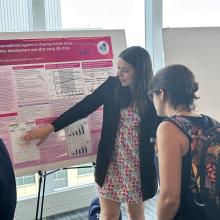Systems neuroscience
The Emonet Lab studies how biological systems compute and how computations are implemented in molecular, neuronal, and network mechanisms by examining how flies navigate their chemical environments. Chemical navigation involves many non-trivial computations, providing a quantitative framework for discovering how brains compute. The research group recently discovered that flies use their olfactory system to detect the motion of odors, using computations similar to those used by the visual system to detect motion. They also examine how flies integrate odor motion detection with other olfactory cues to modulate goal-oriented navigation.
Methods
Topics
Biography
Thierry Emonet earned his MS in physics from ETH Zürich and his PhD in theoretical astrophysics from the University of La Laguna (Spain) in 1998. During his postdoc at NCAR Colorado and The University of Chicago, he discovered mechanisms that enable magnetic fields to float to the surface of the Sun and create sunspots. Emonet became fascinated with how individuality arises and its functional role in life, and he switched to biology. He joined Yale in 2007. Emonet grew up at the intersection of science and art. His spouse is the well-known sculptor Susan Clinard, and he has two sons.


